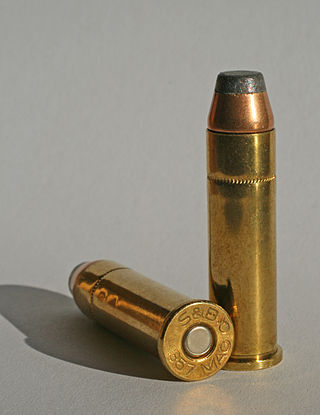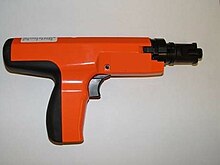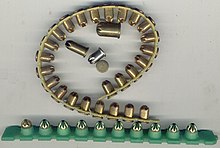
A firearm is any type of gun designed to be readily carried and used by an individual. The term is legally defined further in different countries.

A cartridge, also known as a round, is a type of pre-assembled firearm ammunition packaging a projectile, a propellant substance and an ignition device (primer) within a metallic, paper, or plastic case that is precisely made to fit within the barrel chamber of a breechloading gun, for convenient transportation and handling during shooting. Although in popular usage the term "bullet" is often used to refer to a complete cartridge, the correct usage only refers to the projectile.
A muzzleloader is any firearm, in which the user loads the projectile and the propellant charge into the muzzle end of the gun. This is distinct from the modern designs of breech-loading firearms, in which user loads the ammunition into the breech end of the barrel. The term "muzzleloader" applies to both rifled and smoothbore type muzzleloaders, and may also refer to the marksman who specializes in the shooting of such firearms. The firing methods, paraphernalia and mechanism further divide both categories as do caliber.

An air gun or airgun is a gun that using energy from compressed air or other gases that are mechanically pressurized and released as propellant for the chosen projectiles based on the principle of the primitive blowgun. This is in contrast to a firearm, which fires projectiles using energy by burning combustible propellants, most often gunpowder.
Muzzle velocity is the speed of a projectile with respect to the muzzle at the moment it leaves the end of a gun's barrel. Firearm muzzle velocities range from approximately 120 m/s (390 ft/s) to 370 m/s (1,200 ft/s) in black powder muskets, to more than 1,200 m/s (3,900 ft/s) in modern rifles with high-velocity cartridges such as the .220 Swift and .204 Ruger, all the way to 1,700 m/s (5,600 ft/s) for tank guns firing kinetic energy penetrator ammunition. To simulate orbital debris impacts on spacecraft, NASA launches projectiles through light-gas guns at speeds up to 8,500 m/s (28,000 ft/s). FPS and MPH are the most common American measurements for bullets. Several factors, including the type of firearm, the cartridge, and the barrel length, determine the bullet's muzzle velocity.

A centerfire cartridge is a firearm metallic cartridge whose primer is located at the center of the base of its casing. Unlike rimfire cartridges, the centerfire primer is typically a separate component seated into a recessed cavity in the case head and is replaceable by reloading.

Rimfire ammunition is a type of firearm metallic cartridge whose primer is located within a hollow circumferential rim protruding from the base of its casing. When fired, the gun's firing pin will strike and crush the rim against the edge of the barrel breech, sparking the primer compound within the rim, and in turn ignite the propellant within the case. Invented in 1845, by Louis-Nicolas Flobert, the first rimfire metallic cartridge was the .22 BB Cap cartridge, which consisted of a percussion cap with a bullet attached to the top. While many other different cartridge priming methods have been tried since the mid-19th century onwards, such as pinfire, only small caliber rimfire and centerfire cartridges have survived to the present day with regular usage. The .22 Long Rifle rimfire cartridge, introduced in 1887, is by far the most common ammunition in the world today in terms of units sold.

A gun barrel is a crucial part of gun-type weapons such as small firearms, artillery pieces, and air guns. It is the straight shooting tube, usually made of rigid high-strength metal, through which a contained rapid expansion of high-pressure gas(es) is used to propel a projectile out of the front end (muzzle) at a high velocity. The hollow interior of the barrel is called the bore, and the diameter of the bore is called its caliber, usually measured in inches or millimetres.

The .22 Long Rifle or simply .22 LR or 22 is a long-established variety of .22 caliber rimfire ammunition originating from the United States. It is used in a wide range of rifles, pistols, revolvers, and submachine guns.
Internal ballistics, a subfield of ballistics, is the study of the propulsion of a projectile.

A blank is a firearm cartridge that, when fired, does not shoot a projectile like a bullet or pellet, but generates a muzzle flash and an explosive sound like a normal gunshot would. Firearms may need to be modified to allow a blank to cycle the action, and the shooter experiences less recoil with a blank than with a live round. Blanks are often used in prop guns for shooting simulations that have no need for ballistic results, but still demand light and sound effects, such as in historical reenactments, special effects for theatre, movie and television productions, combat training, for signaling, and cowboy mounted shooting. Specialised blank cartridges are also used for their propellant force in fields as varied as construction, shooting sports, and fishing and general recreation.

Smokeless powder, also referred to as gunpowder, is a type of propellant used in firearms and artillery that produces less smoke and less fouling when fired compared to black powder. The combustion products are mainly gaseous, compared to around 55% solid products for black powder. In addition, smokeless powder does not leave the thick, heavy fouling of hygroscopic material associated with black powder that causes rusting of the barrel.
The .30-06 Springfield cartridge, 7.62×63mm in metric notation, and called the .30 Gov't '06 by Winchester, was introduced to the United States Army in 1906 and later standardized; it remained in military use until the late 1970s. The ".30" refers to the caliber of the bullet in inches, .300 and the "06" refers to the year the cartridge was adopted, 1906. It replaced the .30-03, 6mm Lee Navy, and .30-40 Krag cartridges. The .30-06 remained the U.S. Army's primary rifle and machine gun cartridge for nearly 50 years before being replaced by the 7.62×51mm NATO and 5.56×45mm NATO, both of which remain in current U.S. and NATO service. It remains a very popular sporting round, with ammunition produced by all major manufacturers.

The .22 CB cap is a more powerful version of the .22 BB cap rimfire metallic cartridge, which was invented by Louis-Nicolas Flobert in 1845. The .22 BB cap and .22 CB cap are interchangeable and are relatively quiet, low velocity cartridges, designed for indoor target shooting.
Blowback is a system of operation for self-loading firearms that obtains energy from the motion of the cartridge case as it is pushed to the rear by expanding gas created by the ignition of the propellant charge.

A nail gun, nailgun or nailer is a form of hammer used to drive nails into wood or other materials. It is usually driven by compressed air (pneumatic), electromagnetism, highly flammable gases such as butane or propane, or, for powder-actuated tools, a small explosive charge. Nail guns have in many ways replaced hammers as tools of choice among builders.
This article explains terms used for the British Armed Forces' ordnance (weapons) and ammunition. The terms may have slightly different meanings in the military of other countries.
The following are terms related to firearms and ammunition topics.
In firearms and artillery, the primer is the chemical and/or device responsible for initiating the propellant combustion that will propel the projectiles out of the gun barrel.

A silencer, also known as a sound suppressor, suppressor, or sound moderator, is a muzzle device that suppresses the blast created when a gun is discharged, therefore reducing the acoustic intensity of the muzzle report and jump, by modulating the speed and pressure of the propellant gas released from the muzzle. Like other muzzle devices, a silencer can be a detachable accessory mounted to the muzzle, or an integral part of the barrel.

















